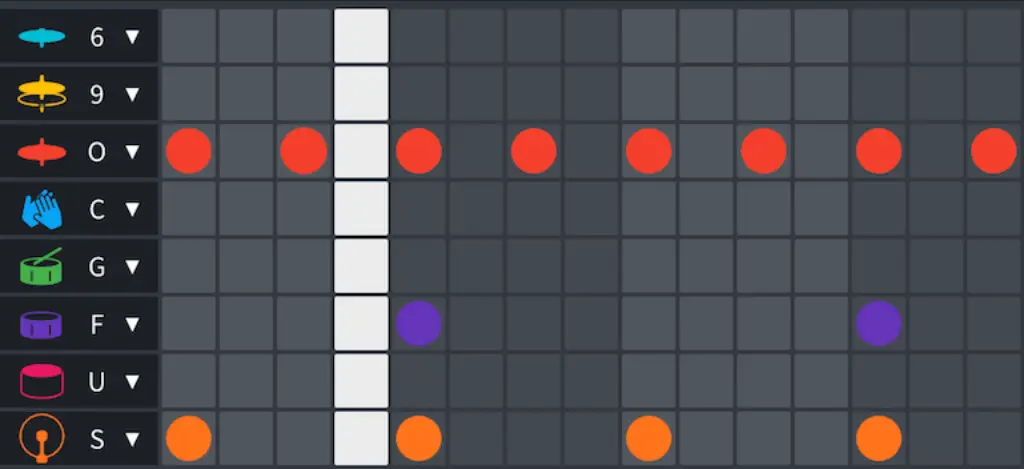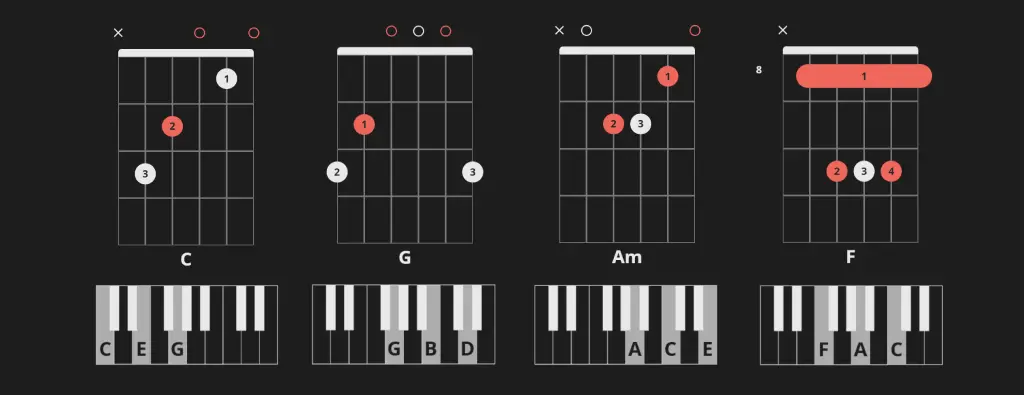When you’re learning music, especially as an adult, everything seems harder than it should be. Your fingers don’t listen. Your mind races ahead. The song that sounded so simple suddenly feels like advanced maths in disguise. But the truth is, music isn’t hard because it’s complicated — it’s hard because you don’t yet know what to look for.
And what you should be looking for — in chords, rhythm, melodies, and structure — is patterns.
- Rhythm basics: How patterns shape the beat
- How chord patterns work in music
- Melody: Repeating shapes and hooks
- How verse, chorus, and bridge create a song’s pattern
- The importance of musical patterns for beginners
Patterns are the hidden scaffolding of music. They’re what make it work, and, more importantly for you, what make it learnable. Once you start seeing music in terms of repeated shapes and loops, you go from surviving it to actually enjoying it. You stop staring at your instrument like it’s some kind of puzzle box, and start thinking, “Hang on, this bit feels familiar...”
So let’s take a look at where those patterns hide, and why spotting them can change everything.
Rhythm basics: How patterns shape the beat
 If you’ve ever clapped along to a song, you’ve already followed a rhythmic pattern. That’s rhythm in its purest form: repeated pulses, divided into equal time units.
If you’ve ever clapped along to a song, you’ve already followed a rhythmic pattern. That’s rhythm in its purest form: repeated pulses, divided into equal time units.
Music, at its root, is just organised sound over time. Time signatures are how we structure that organisation — and they’re full of patterns too. When you see something like 4/4 written at the start of a piece of music, it’s not there to scare you. It’s telling you: “You’re going to hear four beats, over and over, and that’s the grid everything else sits on.”
Most music in the Western world is written in 4/4 — think of it as four walking steps. ONE two three four. Then back to ONE. This structure is so natural that you probably feel it before you know it. Snare drums hit on beats two and four, your foot taps out beat one. It’s a physical loop.
But time signatures can shift the feel dramatically. 3/4 has a lilt — a sway — that’s built for waltzes and certain folk traditions. 6/8 swings forward with momentum. Meanwhile, 5/4 or 7/8 make things sound a little off-kilter, perfect for film scores or songs that want to keep you guessing.
And here's the secret: once you know the pattern, you don’t need to count anymore. Your body does it for you. That’s why rhythm is something you feel just as much as you understand. It’s physical memory, not theory.
➡️Try this:
Next time you hear a song, tap your foot or clap along. Can you find the beat? Is it steady like 4/4, swaying like 3/4, or a bit unpredictable? Don’t overthink it — just feel it. Let your body do the counting.
💡 ARTMASTER TIP: Want to master rhythm without getting lost in counting? Learn how to use a metronome properly — it’s one of the best tools for improving timing→ How to use a metronome: tips for piano, guitar & more
How chord patterns work in music
 Chords are often the first thing beginners learn — and often the first thing they forget. That’s because most people try to memorise chords as isolated facts: “C major looks like this, G major looks like that.” But the real magic in chords happens when you start seeing the relationships between them — when you start spotting the patterns.
Chords are often the first thing beginners learn — and often the first thing they forget. That’s because most people try to memorise chords as isolated facts: “C major looks like this, G major looks like that.” But the real magic in chords happens when you start seeing the relationships between them — when you start spotting the patterns.
Take the classic pop chord progression: C – G – Am – F. You’ve heard it in everything from Let It Be to No Woman No Cry. Why? Because it just works. The emotional arc feels right. It resolves. It circles back.
This isn’t an accident. Chord progressions follow patterns that give songs structure and flow. In music theory, they’re often written using Roman numerals — I, V, vi, IV — so you can apply the same pattern to any key. The chords change, but the pattern doesn’t. It’s like baking the same cake with different flavours.
On piano, chords form shape patterns in your hands. A major triad? Always root – skip – skip. On guitar, open chords can move up the neck and turn into barre chords. Chord shapes become portable. And when you learn to see those shapes as part of a pattern — not just a one-off — they stick.
Understanding chord patterns means you no longer need to memorise 200 songs. You just need to understand how those songs reuse the same patterns in clever ways.
➡️Try this:
Listen to one of your favourite songs — something with a simple, singable vibe. Can you hear the chord changes? Do some parts feel like they “come home” or loop back in a satisfying way? That’s a chord pattern in action. Look up the chords and see if it uses something like C–G–Am–F. You’ll start to notice these patterns everywhere once you know what to listen for.
💡 ARTMASTER TIP: Chord patterns are everywhere in your favourite songs. Discover 100+ songs you can play with just 4 chords.
Melody: Repeating shapes and hooks
 Melody is where many beginners feel lost. Chords seem logical. Rhythm has a grid. But melodies? They can feel like someone talking in a foreign language. You try to copy what you hear, but it slips away before your fingers catch up.
Melody is where many beginners feel lost. Chords seem logical. Rhythm has a grid. But melodies? They can feel like someone talking in a foreign language. You try to copy what you hear, but it slips away before your fingers catch up.
Here’s the thing: most melodies aren’t complicated. They’re familiar. Even the most memorable ones are usually built from small, repeating shapes — little musical Lego blocks.
Take Twinkle Twinkle Little Star. The first phrase goes up, the second matches it exactly, and the third changes direction. That’s not randomness — that’s a motif being repeated with small variations. And the same principle applies in songs by the Beatles, Adele, or Taylor Swift.
Melodies often move in stepwise motion — up or down by one note at a time — with the occasional leap for dramatic effect. Singers use these patterns instinctively. You can too, once you start recognising them.
Even improvisers aren’t making things up from scratch. They’re rearranging familiar melodic fragments in new ways. It’s like telling a new story using words you already know.
When you stop thinking of a melody as a line of individual notes and start hearing it as a shape — a contour — it gets a lot easier to play, sing, or recreate.
➡️Try this:
Pick a favourite chorus — something you catch yourself singing along to. Hum it slowly and notice how the notes move: do they mostly step up or down? Do any parts repeat? Try tracing the shape in the air with your finger. That’s the melody’s contour — and recognising that shape is the first step to playing it by ear or making your own.
💡 ARTMASTER TIP: Want your vocal melodies to sound more individual? Learn how to shape your singing style and bring your own voice to every line.→ How to develop your unique singing style
How verse, chorus, and bridge create a song’s pattern
 We’re taught to think of songs as linear experiences — they start, they go somewhere, they end. But structurally, most songs are circular. They return to the same sections, like old friends dropping in for tea.
We’re taught to think of songs as linear experiences — they start, they go somewhere, they end. But structurally, most songs are circular. They return to the same sections, like old friends dropping in for tea.
Verse–Chorus–Verse–Chorus–Bridge–Chorus is more than just a formula. It’s a pattern that gives music momentum and resolution. The verse tells the story. The chorus delivers the emotional punch. The bridge breaks the repetition before the final round.
And this pattern isn’t just helpful to the listener — it’s incredibly useful for beginners. Once you learn the layout of a song, you only need to learn each section once. If the chorus comes back three times, you don’t have to re-learn it three times.
This is why learning full songs becomes easier once you understand structure. You’re no longer thinking “I have to memorise 100 bars.” You’re thinking “This is three sections, repeated in a set order.”
Even instrumental music follows this logic. Classical forms like sonata or rondo, or modern genres like EDM with their drop–break–build patterns — they’re all based on return and variation.
Understanding structure helps you get out of the weeds and see the whole map.
➡️Try this:
Listen to a song you like and map out its sections. When does the verse start? How many times does the chorus come back? Is there a bridge or a breakdown? You don’t need to name everything perfectly — just start noticing what repeats and when. The more you do this, the easier it gets to learn and remember full songs.
💡 ARTMASTER TIP: If you want to learn to create a fully structured song from scratch, try out our in our Songwriting for Beginners course with Printz Board (Black Eyed Peas).
The importance of musical patterns for beginners
Music isn’t just an art — it’s a language. And like any language, it’s learned not by memorising every word, but by recognising familiar phrases and sentence structures.
Patterns are what connect the technical to the expressive. They give you a foothold in unfamiliar territory. They shrink big, intimidating pieces into manageable chunks. And most importantly, they help you enjoy the process — because instead of always asking “what comes next?” you start saying “oh, I know this bit!”
So whether you’re strumming a chord for the first time, building your first beat, or trying to sing a simple melody — look for the pattern. It’s always there, quietly waiting to help you.
Once you spot it, music becomes a lot less mysterious — and a lot more fun.
The best way to understand patterns? Play them. Our beginner-friendly courses are designed to help you connect the dots, build real skills, and enjoy every step. Try them all free with your 7-day free trial
